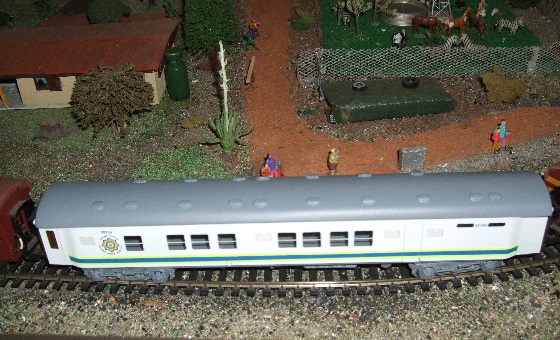Everything on model trains, model railroads, model railways, locomotives, model train layouts, scenery, wiring, DCC and more. Enjoy the world's best hobby... model railroading!
Mobile Police Charge Office South African Railways
Regular contributor Peter Field from South Africa sent in this article to share:
In 2010 when South Africa hosted the world soccer Cup crime was thought to become a problem on certain trains in operation, with drunkenness, rowdiness, and hooliganism.
Transnet built some +-12 mobile police stations which would be attached to certain passenger trains in certain areas where they thought they would experience problems e.g. Johannesburg to Durban and other main cities. These were hooked onto the rear of the train or behind the locomotive.
Should there be any trouble they could be charged on the train and then removed by the police at the destination to be dealt with by the courts. Each coach contained a charge office, counseling office three or so
compartments for the staff to reside in with a shower, toilet, a small kitchenette, and four cells. They fell into disuse after the world soccer cup and were in storage. However, in the last few years, I have seen them attached to container trains that are manned by the police. When the trains are stopped for a long period the police patrol along the train to safe guard the containers from break-ins as theft seems to be a problem at long stops or driver change over points. This method has stopped the break-ins of containers en route to their destinations. This photo shows a mobile police charge office on Peter’s layout.
















I am impressed that they use these cars for policing the
container trains in South Africa.
On this side of the north Atlantic the closest they get to anything like this is when a railroads police department is called to deal with trespassers.
If the container trains stop for long period’s they are subject to break ins and the thieves simply leave the doors open. If the class one or class two operating road is lucky enough a person seeing this will call the watts line number (1-800 number) that is attached to the cross bucks or crossing signals if they are in a municipality and report it.
As we no longer use a caboose for additional crew members on trains it just makes protecting the manifest freights that much harder and they are more vulnerable to having containers opened by thieves.
One issue is the container placement and access door direction as the containers are unable to be rotated to allow the doors to face each other to prevent them from be opened on the manifest trains if they are transporting only 20-foot container cubes.
The TTX well cars used do not have bulk heads. Depending on the model well car they may be the type that are extremely long well cars that carry 53-foot containers on them and loaded with smaller ones and their access doors are also exposed.
If the container cranes used for loading well cars were built with overhead turntables to allow the containers to be rotated the access doors could be placed facing each other and then make it much more difficult to break into them.
It would be possible to do with some ease as a turntable with a spur gear system like the ones used on crawler cranes and drag line cranes could be used for this with minor design changes.